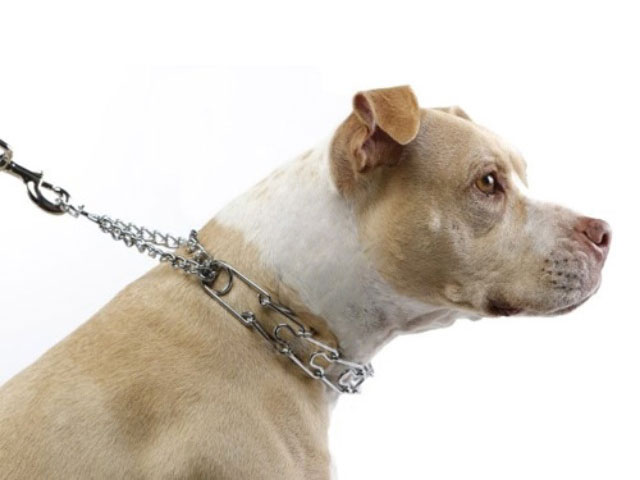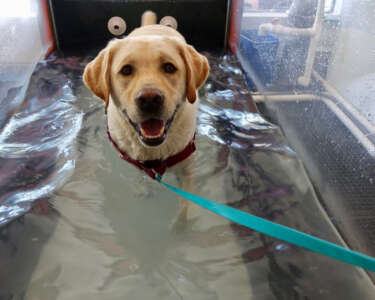You’ve finally adopted a new pet! With the excitement of having a brand new family member we run to the pet or internet store to buy only the best accessories that the market has to offer – Collars, Dog Tags, Bedding, even clothing!. Many times we rely on non-veterinary advice, yet some of these recommendations might not be completely sound, leading to the purchase of a less than adequate pet accessory that may harm your furry friend. In light of new research and a growing understanding of animal behavior, practices and pet accessories that were once acceptable are now considered obsolete. It’s important to keep up with the latest studies in veterinary science in order to offer the best care for our best friends. Let’s review two of the most currently controversial pet accessories:
The Choke Collar
The choke collar was designed as a training tool. A quick pull, and the collar places pressure on the neck drawing the dog’s immediate attention in order to correct a behavior, or to facilitate the learning of a new behavior. The “prong” collar, a variation of the choke collar, was designed with the same purpose but instead, as the collar is pulled on, the prongs not the chain links will place pressure around the neck. The problem is that in both instances owners are reinforcing a desired behavior by utilizing their pet’s fear of being harmed. Studies in animal cognition have revealed that positive reinforcement goes a long way to promote a behavior; results are faster and at the end you will have a pet that loves you, not fears you.
Some will argue that, used humanely, choke or prong collars represent excellent methods to train a dog. The problems are: 1) these collars are available for anyone who wants to buy them, making it difficult to keep in the “right hands;” 2) many times these collars are used incorrectly to walk a dog that pulls on the leash, not necessarily to train them. Dogs wearing these collars are likely to continue pulling on the leash in the future since you haven’t reinforced an alternative behavior – they don’t know the “right” thing to do; 3) choking a dog as negative reinforcement to teach/train is comparable to harming a student in order to to stop an unwanted behavior. The child will likely end up disliking and possibly fearing the teacher.
The use of choke and prong collars is not without other medical risks. The chronic use of these collars could lead to a number of medical conditions. A good example of better device is a harness. There are different types of harnesses ranging from stylish ones disguised as little shirts to the more basic alternatives consisting of a band that surrounds the torso and connects to the regular collar. When the leash is pulled, no pressure is placed on the neck area.
Retractable Leashes
Retractable leashes are very common. Unlike a conventional leash that is approximately six-to-eight feet long, the retractable leash can be as long as 20 or 30 feet. In areas with heavy transit, such as urban areas, they can become a problem. When a dog is so far from its owner, it’s extremely difficult to control its movements while on the leash. As a result, many dogs get into fights, are hit by cars, or have bitten a person while on retractable leashes.
These arguments are convincing enough to have supported the passing of laws restricting the use of retractable leashes in some counties in California. The primary disadvantage of the retractable leash is that its use promotes the unwanted behavior of pulling on the leash. The dog gets rewarded whenever they pull by getting to go wherever they desires, eventually learning that pulling on the leash is acceptable. This goes against what owners want from their pet when they take them for a walk on a leash; for the dog to walk at the owner’s side. A better alternative is a basic six-foot leash. These can be found for free at many veterinary hospitals and pet supply stores. As pet owners, we must always seek for the latest accurate information on animal health care. Always seek reliable sources of information and advice. Ask a professional. Your pet’s vet will have the most recent information and has your pet’s well being as their sole priority.









 Deering Estate
Deering Estate
 Massage Envy South Miami
Massage Envy South Miami
 Calla Blow Dry
Calla Blow Dry
 My Derma Clinic
My Derma Clinic
 Sushi Maki
Sushi Maki
 Sports Grill
Sports Grill
 The Healthy Kitchen
The Healthy Kitchen
 Golden Rule Seafood
Golden Rule Seafood
 Malanga Cuban Café
Malanga Cuban Café

 Kathleen Ballard
Kathleen Ballard
 Panter, Panter & Sampedro
Panter, Panter & Sampedro
 Vintage Liquors
Vintage Liquors
 The Dog from Ipanema
The Dog from Ipanema
 Rubinstein Family Chiropractic
Rubinstein Family Chiropractic
 Your Pet’s Best
Your Pet’s Best
 Indigo Republic
Indigo Republic




 ATR Luxury Homes
ATR Luxury Homes


 2112 Design Studio
2112 Design Studio
 Hamilton Fox & Company
Hamilton Fox & Company
 Creative Design Services
Creative Design Services
 Best Pest Professionals
Best Pest Professionals
 HD Tree Services
HD Tree Services
 Trinity Air Conditioning Company
Trinity Air Conditioning Company
 Cisca Construction & Development
Cisca Construction & Development
 Mosquito Joe
Mosquito Joe
 Cutler Bay Solar Solutions
Cutler Bay Solar Solutions


 Miami Royal Ballet & Dance
Miami Royal Ballet & Dance
 Christopher Columbus
Christopher Columbus
 Pineview Preschools
Pineview Preschools
 Westminster
Westminster
 Carrollton
Carrollton
 Lil’ Jungle
Lil’ Jungle
 Frost Science Museum
Frost Science Museum
 Palmer Trinity School
Palmer Trinity School
 South Florida Music
South Florida Music
 Pinecrest Orthodontics
Pinecrest Orthodontics
 Dr. Bob Pediatric Dentist
Dr. Bob Pediatric Dentist
 d.pediatrics
d.pediatrics
 South Miami Women’s Health
South Miami Women’s Health

 The Spot Barbershop
The Spot Barbershop
 My Derma Clinic
My Derma Clinic




 Miami Dance Project
Miami Dance Project

 Rubinstein Family Chiropractic
Rubinstein Family Chiropractic
 Indigo Republic
Indigo Republic

 Safes Universe
Safes Universe
 Vintage Liquors
Vintage Liquors
 Evenings Delight
Evenings Delight





 Atchana’s Homegrown Thai
Atchana’s Homegrown Thai
 Baptist Health South Florida
Baptist Health South Florida

 Laser Eye Center of Miami
Laser Eye Center of Miami
 Visiting Angels
Visiting Angels
 OpusCare of South Florida
OpusCare of South Florida

 Your Pet’s Best
Your Pet’s Best





 HD Tree Services
HD Tree Services
 Hamilton Fox & Company
Hamilton Fox & Company


 Creative Design Services
Creative Design Services